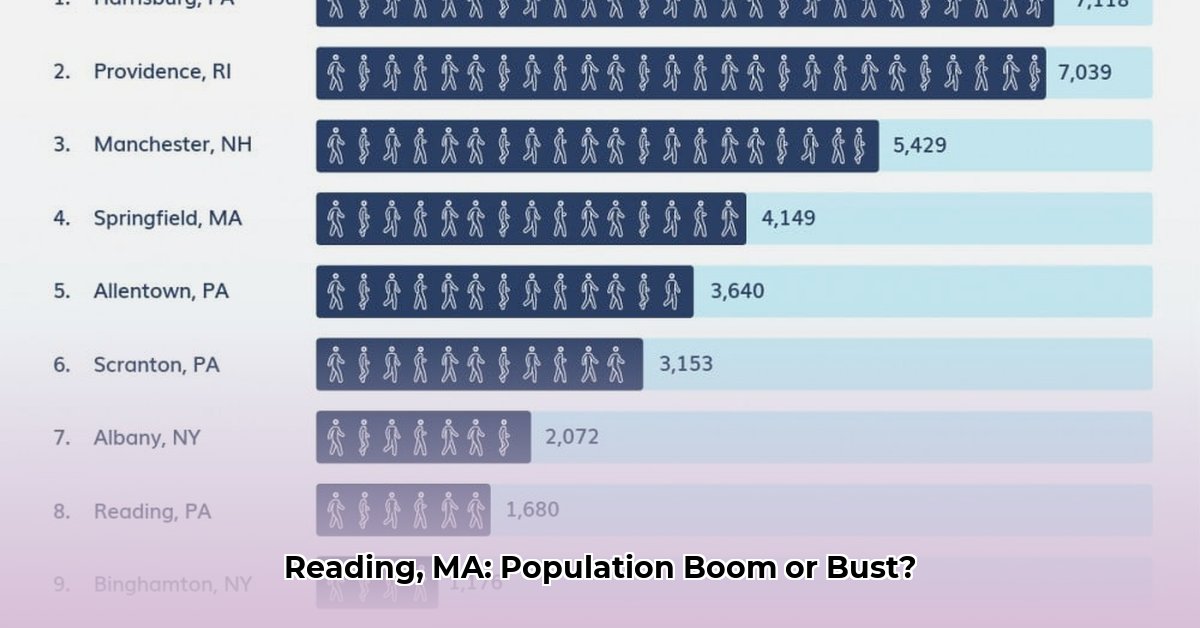
Reading MA Population: A Story of Growth and Change
Reading, Massachusetts—a name echoing with history, community, and a captivating journey through time. Founded in 1644, this town isn't merely a collection of houses and streets; it's a vibrant testament to the evolution of a small colonial settlement into a thriving modern suburb. Let's explore the narrative of Reading's population, its past, present, and the promising possibilities of its future. Understanding this narrative requires examining the economic shifts, community governance, and the ongoing quest for inclusivity.
From Humble Beginnings to Suburban Boom
Imagine the 1640s: a handful of resolute settlers carving out a life from the wilderness, establishing farms, and building a community from the ground up. This was the genesis of Reading. Centuries later, a dramatic shift occurred. The sounds of farm animals were replaced by the hum of industry. Factories, producing goods ranging from furniture and clocks to shoes and even caskets, sprang up, dramatically increasing the population. This industrial boom drew people seeking opportunity, transforming Reading with new homes, improved infrastructure, and a rapidly evolving community. But how did this rapid growth impact social structures and community cohesion?
The Economic Heartbeat: Then and Now
For a considerable period, Reading's economy rested heavily on manufacturing. These industries were more than just income sources; they shaped daily life. Family routines revolved around factory schedules, community events centered on industrial work, and prosperity was directly linked to industrial success. However, like many towns, Reading experienced a transition to a service-based economy. While manufacturing declined, new opportunities emerged in tech, healthcare, and education, creating a more diversified economic landscape. This shift, while offering resilience, also presented complexities, requiring proactive planning to manage economic fluctuations. What strategies have been employed to navigate this economic transformation, and what future challenges lie ahead?
Reading's Numbers: A Glimpse into Census Data
Census data vividly portrays Reading's population growth, revealing a consistent upward trend, though with periods of slower growth and even slight dips. One striking statistic from recent census data: a higher-than-average percentage (around 20.5%) of residents aged 65 and older. This reveals a growing senior population, highlighting the need for increased healthcare and elder care services in the coming years. This presents both a challenge and an opportunity for strategic long-term planning. How can Reading best adapt its infrastructure and services to meet the needs of its aging population while maintaining its vibrant community spirit?
Town Meetings and the Spirit of Community
Reading's unique governance structure, the town meeting, has significantly shaped its identity. This tradition fosters direct citizen involvement in local decision-making, empowering residents and creating a strong sense of community ownership. The town meeting's influence on Reading's development is profound, likely contributing to a stronger sense of cooperation in addressing local issues. However, in a rapidly changing society, how can this traditional model continue to effectively engage and represent a diverse population?
Challenges and Opportunities on the Horizon
Despite its strengths—a high median income and a highly educated population—Reading, like all communities, faces challenges. Affordable housing is a major concern; current high property values could unintentionally exclude individuals from participating in the community. This raises questions about equity and accessibility. Another vital consideration is the town's racial diversity — an opportunity for growth and a richer community experience. How can these challenges be constructively addressed to ensure inclusivity and maintain the town's unique character?
Charting a Course for the Future: Collaboration is Key
Reading's future hinges on the town's effectiveness in addressing these challenges. Collaboration among the town government, residents, historical societies, and local businesses is paramount. Initiatives promoting affordable housing, supporting inclusive growth, and preserving the town's historical charm are crucial steps toward a brighter future for all residents. Reading's narrative is still unfolding, with each chapter shaped by the collective efforts of its community. What collaborative approaches are most effective in fostering community engagement and addressing critical issues?
What We Don't Know (Yet): The Importance of Ongoing Research
While available data offers significant insight into Reading's population, gaps remain. Precise figures on housing inventory, building permits, and employment details are limited. Further research is crucial to fill these gaps, particularly regarding the historical and current racial demographics and the factors shaping them. This is essential for creating a truly inclusive and equitable community. What additional research is needed to provide a more comprehensive understanding of Reading's population dynamics?
Key Takeaways:
- Reading's population has experienced consistent growth, but recent data shows a higher-than-average percentage of residents aged 65+.
- The town's economic base has shifted from manufacturing to a more service-based economy, requiring adaptation and proactive planning.
- The town meeting system fosters community involvement but faces the challenge of engaging a diverse and evolving populace.